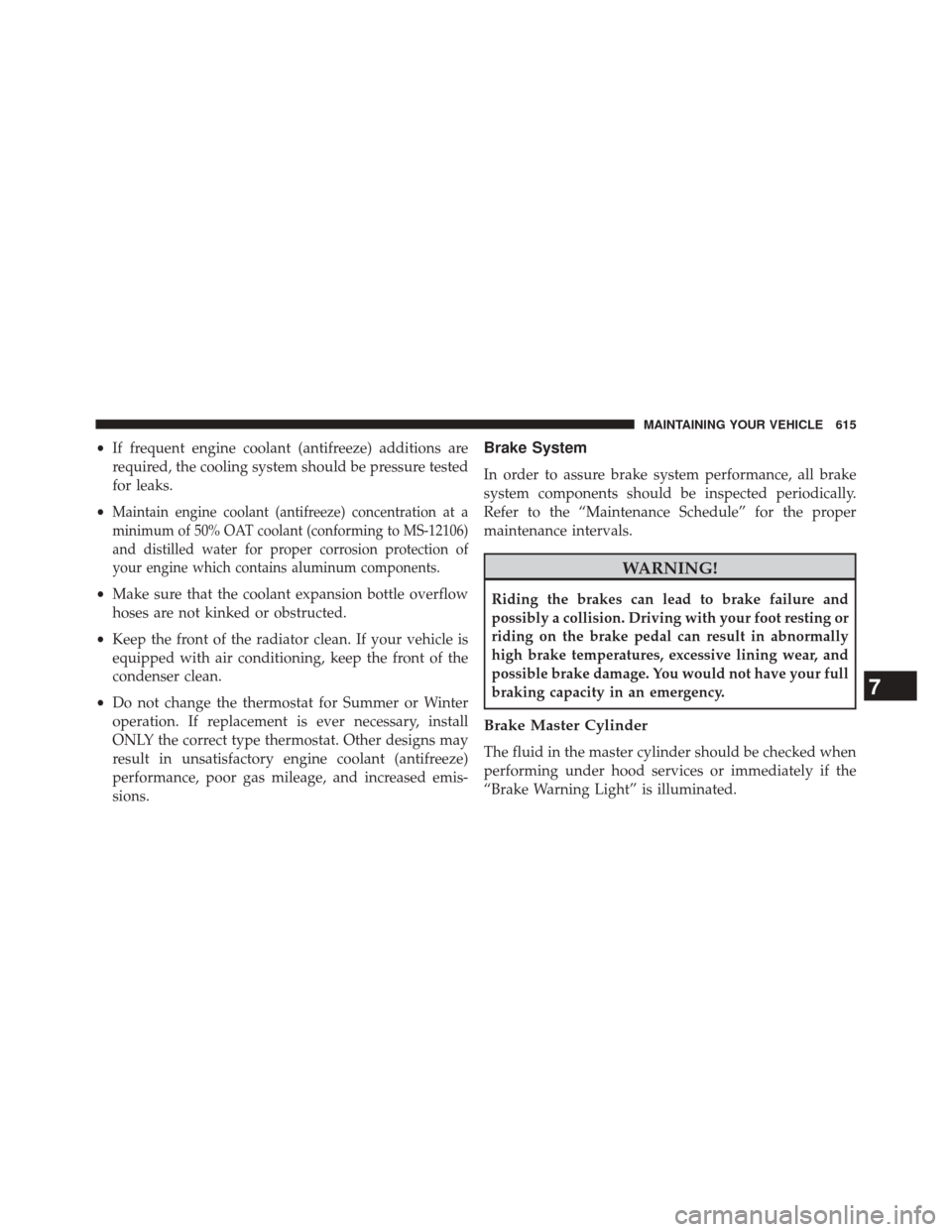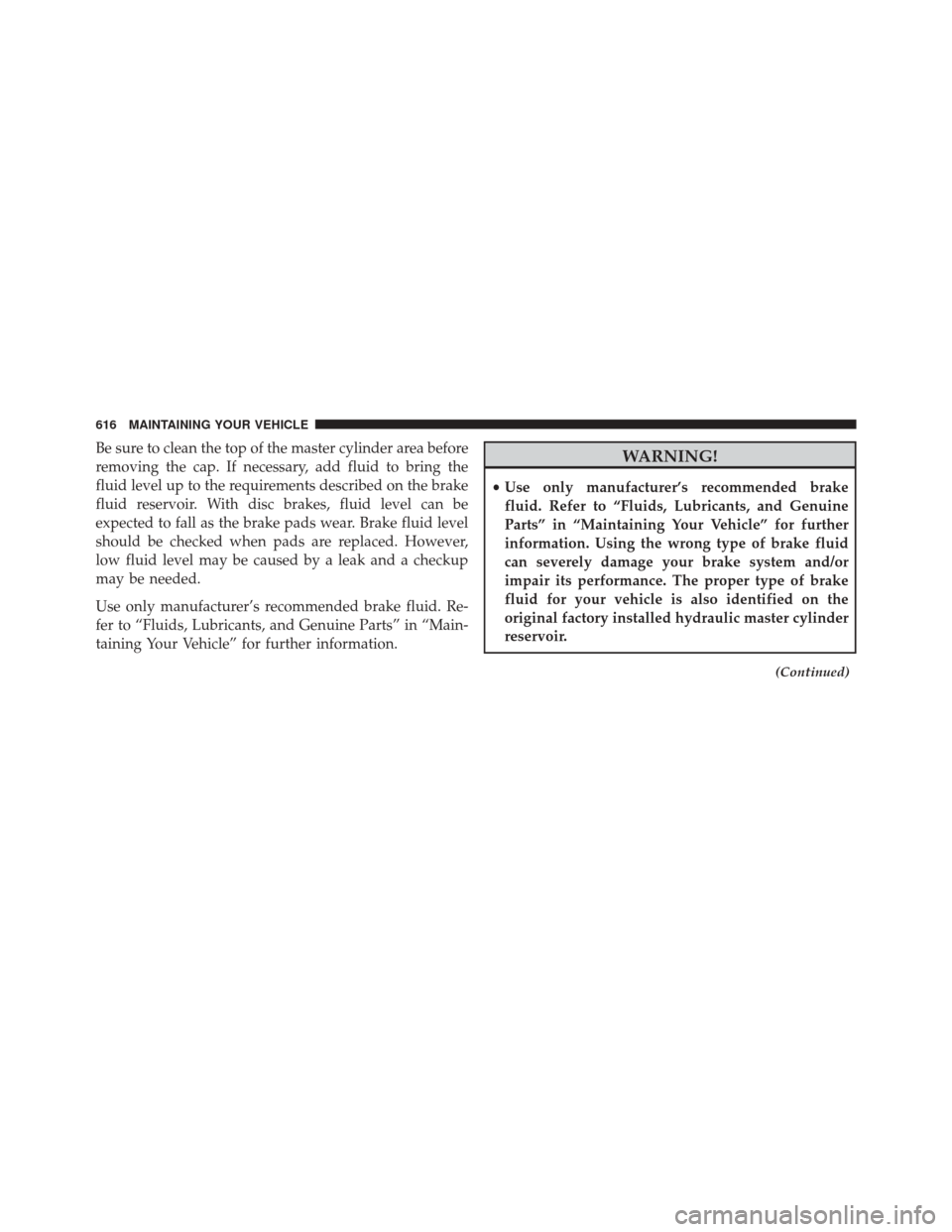Page 373 of 698
Instrument Cluster Messages For (EVIC) And
(DID)
•Front Seatbelts Unbuckled
• Driver Seatbelt Unbuckled
• Passenger Seatbelt Unbuckled
• Service Airbag System
• Traction Control Off
• Washer Fluid Low
• Oil Pressure Low
• Oil Change Due
• Fuel Low
• Service Antilock Brake System
• Service Electronic Throttle Control •
Service Power Steering
• Cruise Off
• Cruise Ready
• Cruise Set To XXX MPH
• Cruise Set To XXX KM/H
• Tire Pressure Screen With Low Tire(s) “Inflate Tire to
XX”
• Service Tire Pressure System
• Parking Brake Engaged
• Brake Fluid Low
• Service Electronic Braking System
• Engine Temperature Hot
• Battery Voltage Low
4
UNDERSTANDING YOUR INSTRUMENT PANEL 371
Page 375 of 698

•Transmission Getting Hot Press Brake
• Trans. Hot Stop Safely Shift to Park Wait to Cool
• Transmission Cool Ready to Drive
• Service Transmission
• Service Shifter
• Engage Park Brake to Prevent Rolling
• Transmission Too cold Idle with Engine On
• Washer Fluid Low
The Reconfigurable Telltales section is divided into the
white telltales area on the right, amber telltales in the
middle, and red telltales on the left.EVIC Selectable Menu Items
Push and release the UP or DOWN arrow buttons until
the desired Selectable Menu icon is highlighted in the
EVIC.
Speedometer
Push and release the UP or DOWN arrow button until
the Speedometer Menu displays in the EVIC/DID. Push
and release the RIGHT arrow button to toggle
between km/h and MPH and push the OK button to
select your speedometer display.
Vehicle Info
Push and release the UP or DOWN arrow button until
the Vehicle Info icon is highlighted in the EVIC/DID.
Push and release the RIGHT arrow button and Coolant
Temp will be displayed. Push the LEFT or RIGHT arrow
4
UNDERSTANDING YOUR INSTRUMENT PANEL 373
Page 560 of 698

4. Remove the cap from the valve stem and then screwthe fitting at the end of the Sealant Hose (6) onto the
valve stem.
5. Uncoil the Power Plug (8) and insert the plug into the vehicle’s 12 Volt power outlet.
NOTE: Do not remove foreign objects (e.g., screws or
nails) from the tire.
(C) Injecting Tire Service Kit Sealant Into The
Deflated Tire:
• Always start the engine before turning ON the Tire
Service Kit.
NOTE: Manual transmission vehicles must have the
parking brake engaged and the shift lever in NEUTRAL.
• After pressing the Power Button (4), the sealant (white
fluid) will flow from the Sealant Bottle (1) through the
Sealant Hose (6) and into the tire. NOTE:
Sealant may leak out through the puncture in the
tire.
If the sealant (white fluid) does not flow within0–10
seconds through the Sealant Hose (6):
1. Press the Power Button (4) to turn Off the Tire Service Kit. Disconnect the Sealant Hose (6) from the valve
stem. Make sure the valve stem is free of debris.
Reconnect the Sealant Hose (6) to the valve stem.
Check that the Mode Select Knob (5) is in the Sealant
Mode position and not Air Mode. Press the Power
Button (4) to turn On the Tire Service Kit.
2. Connect the Power Plug (8) to a different 12 Volt power outlet in your vehicle or another vehicle, if
available. Make sure the engine is running before
turning ON the Tire Service Kit.
3. The Sealant Bottle (1) may be empty due to previous use. Call for assistance.
558 WHAT TO DO IN EMERGENCIES
Page 589 of 698
MAINTAINING YOUR VEHICLE
CONTENTS
�ENGINE COMPARTMENT — 2.4L ..........589
� ENGINE COMPARTMENT — 3.6L ..........590
�
ONBOARD DIAGNOSTIC SYSTEM — OBD II . . .591
▫ Loose Fuel Filler Cap Message ............591
� EMISSIONS INSPECTION AND MAINTENANCE
PROGRAMS ......................... .592
� REPLACEMENT PARTS ..................593
� DEALER SERVICE ..................... .593
� MAINTENANCE PROCEDURES ...........594
▫ Engine Oil ......................... .595▫
Engine Oil Filter ..................... .598
▫ Engine Air Cleaner Filter ................598
▫ Maintenance-Free Battery ...............599
▫ Air Conditioner Maintenance .............601
▫ Body Lubrication .....................605
▫ Windshield Wiper Blades ...............605
▫ Adding Washer Fluid ..................606
▫ Exhaust System ..................... .607
▫ Cooling System ..................... .609
▫ Brake System ....................... .615
7
Page 591 of 698
ENGINE COMPARTMENT — 2.4L
1 — Air Cleaner Filter5 — Power Distribution Center (Fuses)
2 — Engine Coolant Pressure Cap 6 — Battery
3 — Oil Fill Cap 7 — Washer Fluid Reservoir
4 — Brake Fluid Reservoir 8 — Engine Oil Dipstick
7
MAINTAINING YOUR VEHICLE 589
Page 592 of 698
ENGINE COMPARTMENT — 3.6L
1 — Engine Coolant Reservoir5 — Washer Fluid Reservoir
2 — Engine Oil Filter Access Cover 6 — Battery
3 — Brake Fluid Reservoir 7 — Engine Oil Fill
4 — Power Distribution Center (Fuses) 8 — Air Cleaner Filter
590 MAINTAINING YOUR VEHICLE
Page 617 of 698

•If frequent engine coolant (antifreeze) additions are
required, the cooling system should be pressure tested
for leaks.
•
Maintain engine coolant (antifreeze) concentration at a
minimum of 50% OAT coolant (conforming to MS-12106)
and distilled water for proper corrosion protection of
your engine which contains aluminum components.
• Make sure that the coolant expansion bottle overflow
hoses are not kinked or obstructed.
• Keep the front of the radiator clean. If your vehicle is
equipped with air conditioning, keep the front of the
condenser clean.
• Do not change the thermostat for Summer or Winter
operation. If replacement is ever necessary, install
ONLY the correct type thermostat. Other designs may
result in unsatisfactory engine coolant (antifreeze)
performance, poor gas mileage, and increased emis-
sions.
Brake System
In order to assure brake system performance, all brake
system components should be inspected periodically.
Refer to the “Maintenance Schedule” for the proper
maintenance intervals.
WARNING!
Riding the brakes can lead to brake failure and
possibly a collision. Driving with your foot resting or
riding on the brake pedal can result in abnormally
high brake temperatures, excessive lining wear, and
possible brake damage. You would not have your full
braking capacity in an emergency.
Brake Master Cylinder
The fluid in the master cylinder should be checked when
performing under hood services or immediately if the
“Brake Warning Light” is illuminated.
7
MAINTAINING YOUR VEHICLE 615
Page 618 of 698

Be sure to clean the top of the master cylinder area before
removing the cap. If necessary, add fluid to bring the
fluid level up to the requirements described on the brake
fluid reservoir. With disc brakes, fluid level can be
expected to fall as the brake pads wear. Brake fluid level
should be checked when pads are replaced. However,
low fluid level may be caused by a leak and a checkup
may be needed.
Use only manufacturer’s recommended brake fluid. Re-
fer to “Fluids, Lubricants, and Genuine Parts” in “Main-
taining Your Vehicle” for further information.WARNING!
•Use only manufacturer’s recommended brake
fluid. Refer to “Fluids, Lubricants, and Genuine
Parts” in “Maintaining Your Vehicle” for further
information. Using the wrong type of brake fluid
can severely damage your brake system and/or
impair its performance. The proper type of brake
fluid for your vehicle is also identified on the
original factory installed hydraulic master cylinder
reservoir.
(Continued)
616 MAINTAINING YOUR VEHICLE